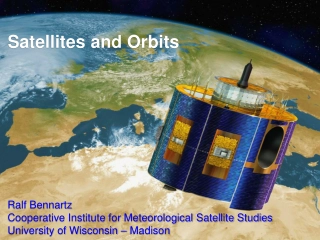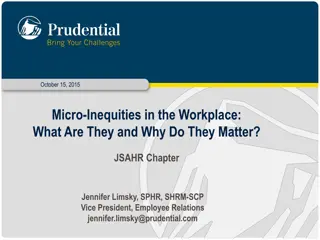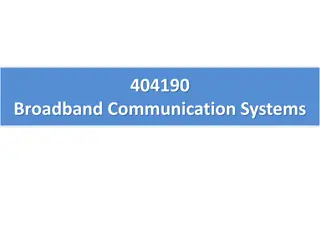Ecosystem for Micro and Small Satellites Based on 3U-ADHA Modules
This presentation discusses the development of an ecosystem for micro and small satellites using 3U-ADHA modules and units. It covers the background, mission criticality classes, small satellite avionics needs, and proposes a standardized modular system for small satellites. The overview includes examples of small satellite buses in Europe and their usage in institutional missions.
Download Presentation

Please find below an Image/Link to download the presentation.
The content on the website is provided AS IS for your information and personal use only. It may not be sold, licensed, or shared on other websites without obtaining consent from the author.If you encounter any issues during the download, it is possible that the publisher has removed the file from their server.
You are allowed to download the files provided on this website for personal or commercial use, subject to the condition that they are used lawfully. All files are the property of their respective owners.
The content on the website is provided AS IS for your information and personal use only. It may not be sold, licensed, or shared on other websites without obtaining consent from the author.
E N D
Presentation Transcript
An Ecosystem for Micro- and Small-Satellites Based on 3U-ADHA Modules and Units David Steenari1, Felix Siegle1, Kostas Marinis1, Malte Bargholz1, Maris Tali1, Olivier Mourra1 1 ESA/ESTEC ESA ESTEC 07/10/2023 1 ESA UNCLASSIFIED For ESA Official Use Only
Presentation Background New ESA Mission Criticality Classes have recently been defined, including Class IV for low-cost missions (>50MEUR). New ESA COTS Component Classes (Q1/Q2) targeting COTS microelectronics that does not provide lot traceability. Ever higher interest for Small- and Micro-Satellites. ESA institutional small- and micro-satellite missions being developed. Lack of standardization for Small- and Micro-Satellite Avionics Different providers different approaches. Image: ADHA-6U and ADHA-3U ADHA-2 Study on-going, achieved agreement on modularity and backplane. Proposal: reuse ADHA-2 study outcomes for standardized modular avionics and data handling systems for small- and micro-satellites. 2
Presentation Overview 1. Small- and Micro-Satellites: a) Examples of Small- and Micro-Satellite Buses in Europe b) Small- and Micro-Satellite Usage in European Institutional Missions 2. ESA Mission Criticality Classes and New Component Classes 3. ADHA-2 Study Status 4. Small- and Micro-Satellite Avionics Needs 5. Proposed 3U-ADHA Ecosystem for Small- and Micro-Satellites a) Overview of possible 3U modules b) Overview of possible 3U units 6. Conclusions 3
1.a. Examples of Small- and Micro-Satellite Buses in Europe The number of small- and micro-satellite platform providers in Europe has quickly increased in recent years. Several have been developed in cooperation with ESA, others on national funding, or private investments. Driven by requirements for better performance than Cubesats but lower costs than traditional space missions. Below we provide a list of some example providers and platforms. Note: These are just a few examples of S/C buses in Europe, and should be no means be taken as a complete overview. All data collected from public references. List of references are provided in the paper. Clear that small and micro-satellite have become a market with high interest. Company Country S/C Platform S/C 120-150kg, 320-640 Mbit/s (downlink), 5 year (LEO) P/L Berlin Space Systems Germany LEOS-100 -HR/-HP 30-75 kg, 60-300 W Kongsberg NanoAvionics Lithuania MP42 -/-H/-D 50-150 kg, 200 Mbit/s (downlink) 15-60 kg, 87-218 W OHB LuxSpace Luxembourg Triton-X -L/-M/-H 40-250 kg, 800 Mbit/s (downlink), 5 year (LEO) 15-90 kg, 20-31 W OHB Sweden Sweden Innosat 30-300 kg, 800 Mbit/s (downlink), 3-7 years (LEO) 150 kg, 120 W QinetiQ (RedWire) Belgium P200 Gluon Lite/Endure/Explorer 130 kg, 400 Mbit/s (downlink), 7 years 70-100 kg, 120 W ReOrbit Finland 200-500 kg, 3-8 years (LEO) 50-150 kg, 100-300 W SSTL UK SSTL -MICRO / -MINI >30kg, 140-1000 Mbit/s (downlink), 7 years (LEO) 65kg, 63 W Thales Alenia Space Italy NIMBUS - 150-200 kg, 100 W 4
1.b. Small- and Micro-Satellite Usage in European Institutional Missions An increasing number of small- and micro-satellites being procured as institutional missions. Note: These are just a few examples of missions, and should be no means be taken as a complete overview. PROBA-3 Arctic Weather Satellite (AWS) PROBA-V Auroral Monitoring Mission VISDOMS / SBOC 5 5
3. ADHA-2 Study Status ADHA-2 studies currently being conducted between ESA and Industry (ADS, TAS, OHB, DSI, Beyond Gravity) ADHA (Advanced Data Handling Architecture) overview already covered by other presentations at EDHPC. Key take-aways: System level requirements, based on ESA Institutional HPCM (High Priority Copernicus Missions). Module and Unit architecture defined. Module procurement flow defined. Backplane connector defined for both 6U and 3U form-factors. For first module developments primarily targeting 6U-ADHA Modules for Class I type missions. Image: ADHA-6U and ADHA-3U 9
4. Small- and Micro-Satellite Avionics Needs To summarize, small- and micro-satellites have a number of high-level constraints that may have an impact on the DHS, e.g.: SWaP (Size, Weight and Power) must be compatible with S/C small-/micro-platform requirements Lifetime nominal 5 years in LEO, with a span of 2-7 years Total mission budgets in tens of MEURs up to a hundred MEUR Acceptable reliability and availability, per mission criticality requirements Compatibility with ground station systems, e.g. CCSDS, AES encryption, etc. Downlink of a few hundred Mbit/s Data storage of a few hundred Gbits up to a few tens of Tbits Payload buffering data rates of a few hundred Mbit/s to Gbit/s Systems scalable (in terms of functionality and performance) over the product life-time 10
5. Proposed 3U-ADHA Ecosystem for Small- and Micro-Satellites 1 of 3 Based on the constraints, the following requirements for an ADHA-based avionics suite for small satellites is considered: Size: Mainly 3U-ADHA considered Lifetime: 5 years in LEO, minimum Fully compliant with Class III and/or (depending on target) Class IV requirements Synergy between Class III and Class IV by selection of key components available as COTS and RT. Budget: Utilize screened commercial components for non-critical applications (e.g. ECSS (Q0) class III, or Q1) for Class IV. Radiation testing: TID (lifetime) on module or components level Screen components for destructive SEE effects, and characterise SEFIs. Proton for SEE effects (on component or module level). Heavy ion testing on critical components (or all for Class III) Reliability: Avoid Single-Points-of-Failure (SPoF) through: module level redundancy, bus redundancy, and interface cross-strapping. Use rad-hard components for critical functions. Availability: Implement local fault-mitigation mechanisms on module level. 11
5. Proposed 3U-ADHA Ecosystem for Small- and Micro-Satellites 2 of 3 Operations: Compatibility with CCSDS and PUS-C, as well as AES for encryption Compatibility with commercial ground station providers also desired. Internal unit backplane interfaces Fully compliant with ADHA backplane. Utilize only the CAN bus for commanding of lower-level modules for non data-processing functions High-rate SpW and SpFi internal backplane interfaces between modules within a unit Use of redundant CAN bus for commanding between unit-to-unit. With support for additional RS422 interfaces for lower level units. High-speed on-board interfaces (SpW, SpFi, Ethernet, etc) for payload and downlink unit-to-unit interfacing, few hundred Mbit/s up to one Gbit/s Ethernet a popular payload interface in Small-Satellites can be supported on front-panel on specific modules. 12
5. Proposed 3U-ADHA Ecosystem for Small- and Micro-Satellites 3 of 3 Benefits of ADHA eco-system: Recurrence Core modules can be reused over multiple missions, with different performance/interface requirements Interoperability Modules/technology from different suppliers can be integrated in in-house units, without hardware NRE Flexibility New functions / interfaces / performances can be integrated without requiring hardware redesign of core modules Scalability Increased performances can be supported by the data handling system, simply by adding more of the same modules Lowered NRE costs Platform providers can cover mission-specific functionalities and performance by utilization of 3rd party ADHA module suppliers Improved quality By reusing the same recurrent modules, the quality of the end-to-end solution can be increased over time due to increased heritage Increased competitiveness By allowing the procurement of modules instead of only full electronics units, it allows the entry of SMEs to quickly enter the market, and hence increasing the competitiveness - and the options for platform providers 13
5.a. Proposed 3U-ADHA Ecosystem for Small- and Micro-Satellites Modules At least the following modules would need to be developed: ADHA-3U Processor Modules / Single-Board Computer for OBC/ICU/MM See e.g. EvoLeo CHICS OBC board based on PolarFire+ZynqUS+ currently under development. For critical functions, other concept, e.g. GR740 in plastic package could be considered. LS1046A and Versal AI Edge also options both available as COTS and RT ADHA-3U Mass-Memory Modules Same concept as with 6U: multiple mass-memory extension modules High-density FPGA with high-speed links, high-rate buffers (DDR4) and many non-volatile memories (Flash) ADHA-3U Co-Processing Modules Based on high-density FPGAs and multi-core processors. Provides high-speed links to payloads. ADHA-3U I/O Modules provides low-level interfaces for platform RIU functions, or payload (FEE) I/O functions ADHA-3U Power Modules Additional modules for other functions (OBC reconfiguration, critical TC/TM, GNSS RF front-end, etc) also to be considered. 14
5.b. Proposed 3U-ADHA Ecosystem for Small- and Micro-Satellites Units Based on the mentioned modules, different units can be built up (Power Module not repeated) depending on mission needs: Platform DHS OBC / CDHU (Command and Data Handling Unit) SBC module and reconfiguration and TM/TC decoder/encoder module MM controller module and MM extension modules I/O modules for platform avionics equipment interfacing ("RIU" functions) Optional: GNSS RF front-end module Optional: Additional I/O modules for payload interfacing Stand-alone Payload Mass-Memory: Mass-memory controller (SBC) Mass-memory extension module(s) Optional: Co-Processing module(s) Power Module Payload ICU / DPU: ICU module (SBC) Co-Processing Module(s) Optional: Payload I/O Modules (e.g. FEE module) Optional: Payload power distribution/conditioning modules 15
6. Conclusions Background: Small- and Micro-Satellites have become increasingly popular in the last years. ESA has defined new mission criticality classes that are suitable for small-satellites. The ADHA-2 study has defined a backplane for 6U and 3U modules. In this paper presentation we propose to use 3U-ADHA modules and units targeting ESA Mission Class III and IV missions. Using a mix of RH/RT/COTS components This paper presentation is a starting point to explore the possibility of 3U-ADHA for Small-and Micro-Satellites Will require more detailed study in ESA activities in collaboration with industry. Feedback and input from industry is highly appreciated. Companies interested in working on 3U-ADHA encouraged to get in contact with ESA ADHA team 16
An Ecosystem for Micro- and Small-Satellites Based on 3U-ADHA Modules and Units David Steenari1, Felix Siegle1, Kostas Marinis1, Malte Bargholz1, Maris Tali1, Olivier Mourra1 1 ESA/ESTEC Thank you for your attention! Contact: David.Steenari@esa.int Olivier.Mourra@esa.int ESA ESTEC 07/10/2023 17 ESA UNCLASSIFIED For ESA Official Use Only




![[PDF⚡READ❤ONLINE] Neptune: The Planet, Rings, and Satellites](/thumb/21522/pdf-read-online-neptune-the-planet-rings-and-satellites.jpg)


















